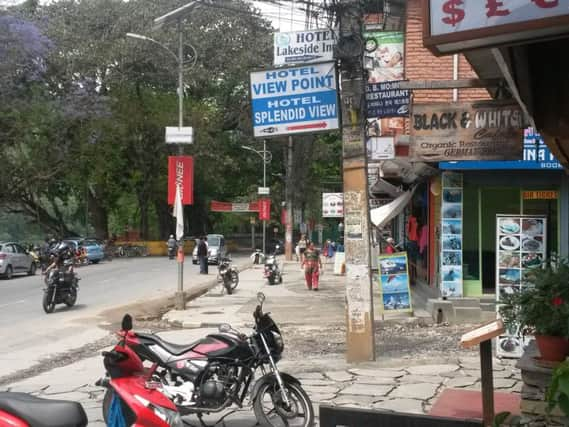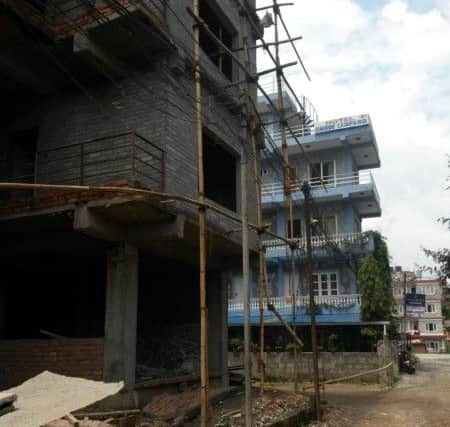First hand account of the Nepal earthquake


Rachel (33), who is a triplet, spent her teenage years in Stornoway, attending the Nicolson Institute and Sandwickhill School before that, with her sister Emma and brother Ross.
There was the beep of a horn and a futile look down the street for the truck that was causing the vibration. We searched for the answer on each other’s faces, but we already knew. The flower pots next to us were wobbling uncontrollably, signs on the street were shaking…the tremors were intensifying. We jumped to our feet and momentarily glanced around at the other people who, moments before, had been calmly drinking tea and eating cinnamon rolls or masala omelettes. Pete voiced the reality: “It’s an earthquake. Run!” There was the sudden sound of chairs scraping the floor, and the continuing low rumble of the tremors. We grabbed our bags and ran out into the street, relieved that we were on the ground floor.
Advertisement
Hide AdAdvertisement
Hide AdOnce outside, I looked up to my right and saw bricks falling from a construction site further along the street. The whole structure was unstable and it seemed certain that it would crumble. I stared aghast at a lone construction worker who stood transfixed at the top of the building, near where the bricks were dislodging themselves, clinging to the rudimentary bamboo scaffolding. Why wasn’t he running to save himself? I knew the answer: up there, the shaking would make movement almost impossible.


A frightened solo traveller followed us out of The Black & White café, still clinging to her half-full glass of lassi, and asked, “I’m travelling on my own. Can I stay with you guys?” The three of us ran across the road to get away from the buildings, and waited for the seemingly endless tremors to stop. It was as if we were standing on water and we felt dizzy and terrified. Bizarrely, whilst this was happening, a Nepali man calmly approached us to offer his services as a trekking guide, illustrating either his complete denial of what was happening, or reflecting the opportunism that is essential to make a living in one of the world’s poorest countries! It took over one minute for the shaking to subside, then we attempted to chat to Franziska (while the geographer in me contemplated epicenter, magnitude, impacts and aid). I thought of Kathmandu and our friends there, and of all the small villages and ramshackle buildings that we had passed on our eight-hour bus journey to Pokhara from Kathmandu the previous day. Had the people we had seen and met along the way survived? When would we be able to let our friends and family know that we were safe, and stop them from worrying?
It was difficult to ascertain when the tremors actually stopped, as our legs kept shaking for a while longer. A few people, including the waiters from The Black & White Café, crossed the road and went back indoors soon after the tremors stopped, but the majority remained on the lake side of the street for a while longer. It felt quite absurd when we eventually returned to the café and requested our bill! Like us, the waiters were of course in shock, and said that while there had been very small tremors for the previous two weeks, this was the biggest and longest earthquake they had ever experienced. They were remarkably matter-of-fact about it and remained professional, even though they must have been incredibly concerned about family members and friends.
Rachel Hay - RSGS Education Officer story from Nepal Earthquake
The Black & White Café, Lakeside, Pokhara
Advertisement
Hide AdAdvertisement
Hide AdFranziska was keen to collect some of her things from her hotel, The Snow Leopard, in case of aftershocks, so we accompanied her on the short walk there. We passed small groups of anxious people on the way, and felt very nervous as we passed another incomplete, poor-quality brick building with the ubiquitous bamboo scaffolding.
I felt scared as Franziska and I climbed the stairs to her room on the second floor, while everyone else waited outside. The nervous tension was palpable and I was keen to spend as little time as possible on the second floor of the hotel. While Franziska quickly collected a few of her belongings, and picked up the two large bottles of water that had fallen from the chest of drawers during the quake, I used the bathroom (praying that an aftershock wouldn’t strike!). I waited outside the room for Franziska, and anxiously looked across at the red-brick building, and also at the hotel directly across from me, wondering if the large crack was new, or had existed before the earthquake. I nervously looked down at the street two floors below, and saw Pete waiting anxiously for us. At that moment, everything began to shake intensely again. I felt torn: wait for Franziska or run for it? I chose the latter, while screaming Franziska’s name. The stairs seemed to jerk and shift as I ran, and I felt sure that the ceiling would cave in on top of me. How would Pete explain to my parents that after surviving the main shock, and against my better judgement, I was killed on the second floor of someone else’s hotel, just because I needed the loo!? Pete was yelling my name and the hotel owner was yelling for Franziska. I ran to Pete then, along with the hotel owner, ran past the red-brick building. Fortunately, Franziska was not far behind us. I was suddenly terrified that the two earthquakes we had experienced so far had actually been foreshocks in the build up to an even bigger event. The stability and safety of our flat in Perth seemed very distant.
Rachel Hay - RSGS Education Officer story from Nepal Earthquake
The ubiquitous bamboo scaffolding on the incomplete red-brick building beside The Snow Leopard Hotel
Advertisement
Hide AdAdvertisement
Hide AdWe waited for a while in the street with a group of locals who were frantically trying to get hold of their relatives and friends in other parts of Nepal, and with other tourists who were trying to access wi-fi to reassure their loved ones back home. Mahima, a friend in Kathmandu, phoned us to ask if we were safe. We asked her to contact a mutual friend, currently living in Honduras, to ask her to post a message on Facebook on our behalf to let our friends and family know that we were safe. After a love-hate relationship with Facebook, its huge value during a natural disaster was immediately apparent. It was such a relief to get a message out and reduce the stress and worry that our families back in the UK would certainly feel when they woke up to the headlines.
Unbelieveably, The Snow Leopard Hotel’s wi-fi was still working and when we ventured close enough to use it, it was amazing to see that the earthquake already featured on the BBC News website. Twitter seemed to load more effectively than any other websites, so we relied on it for updates. Twitter has been invaluable for keeping in touch with the outside world, and for accessing useful information about the on-going crisis. One of my contacts joked that I was in ‘one helluva [sic] Geography lesson!’
Surprisingly quickly, mobile phones and social media were bringing us snippets of information from the capital, Kathmandu. We heard that the Dharahara Tower, which we had seen only the week before, and had considered climbing, had collapsed. I felt sick thinking of all the people who would have been trapped on it as it fell. I later read that one man lost six family members, including his daughter, in the collapse. How can one person cope with the immense stress of that? We then heard that Kathmandu and Patan Durbar Squares had been severely damaged. With Saturday being the holy day in Nepal, there were sure to be many Hindus and Buddhists worshipping in the old temples. Did they all get to safety? I dread to think what the impact would have been had the earthquake struck either on a school-day, or at night, when more people would have been at risk of being indoors when buildings collapsed. Another sickening realisation was that if the earthquake had struck at exactly the same time the previous Saturday, Pete and I would have been in amongst the temples of Kathmandu Durbar Square, in the wrong place at the wrong time, and our families might still be waiting for news on our whereabouts. Trekking in the Langtang area was also on the cards for Saturdaz 25th April…
Now, five days after the M7.8 earthquake, we have experienced numerous aftershocks, ranging from barely perceptible to M6.7, and have been ready to run at any moment, with a bag of supplies always to hand. The fear and uncertainty, combined with the unending flow of images and soundbites from Kathmandu, are exhausting, even though we are in a relatively safe area, and do not have family or property here. We can only imagine the stress and suffering of those in the worst hit areas in Kathmandu who are living in make-shift camps, with very limited supplies of water, food and medicine. I wonder whether the media have communicated the current situation across the country accurately, including the geographical variations of the impacts. The footage of the death and destruction in Kathmandu is a complete contrast to conditions here in Pokhara, where no buildings collapsed and where shops, cafes and restaurants have operated as normal (probably more through economic necessity and the need for routine than anything else) since the day after the earthquake. When we tell our friends and family about what it is like here in Pokhara, they can barely believe it, given the depressing images they are constantly seeing on their screens.
Advertisement
Hide AdAdvertisement
Hide AdWe are incredibly fortunate that, all being well, we can board a plane to Edinburgh within the next few days and leave this terrible and uncertain situation behind. But what will happen to Nepal and its people when the media’s lens moves on, as it inevitably will? Nepal was already one of the poorest countries in the world, ranked 145th out of 187 countries on the United Nation’s 2013 Human Development Index. What will the international community do to help to alleviate the suffering here? Will there be a coordinated plan to ensure that rigorous building codes are enforced, and will other crucial lessons be learned from this disaster that can increase Nepal’s resilience to earthquakes in the future? One thing is certain: Saturday’s earthquake and the aftershocks lasted just minutes, but the people of Nepal will need support from other nations for a long time to come.
People camp outside after the earthquake strikes Pokhara in Nepal.
People camp outside after the earthquake strikes Pokhara in Nepal.
Rachel Hay is still in Nepal with her boyfriend Pete Buckley, the two hope to be returning to Kathmandu in order to take a plane back to the UK on Sunday. You can follow Rachel on Twitter @geogrhay for the latest updates from her.